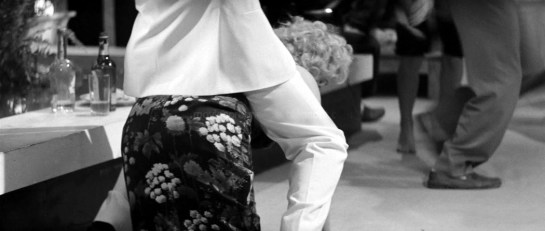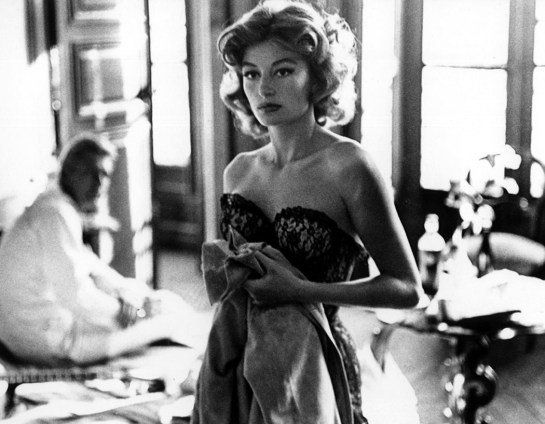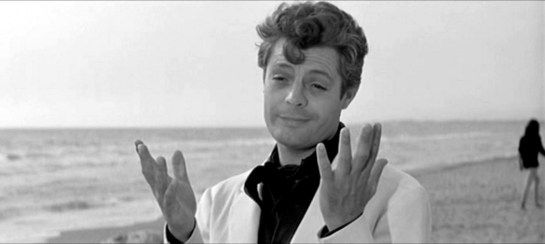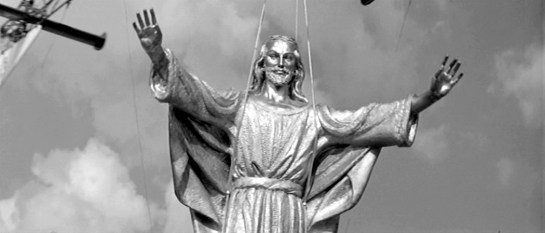La Dolce Vita
Film critic Pauline Kael famously called Citizen Kane “more fun than any other great movie.”
Classic film, like classic literature, sometimes has the reputation of being more “good for you” than it is fun.
Well, Fellini’s La Dolce Vita gives Kane a run for his money.
The great 1960 Italian classic of the Roman “sweet life” in the postwar years shows us nine days and eight nights in the life of tabloid celebrity journalist Marcello Rubini (Marcello Mastroianni) as he negotiates personal relationships, professional crises and spiritual doldrums.
“Rarely, if ever, has a picture reflected decadence, immorality and sophistication with such depth,” Box Office magazine said when the film was released. La Dolce Vita shows up on most all-time 10-best lists, and Fellini is unquestionably one of the four greatest directors ever.
Take its famous opening scene: A helicopter carries a giant statue of Jesus over the landscape of Rome.
The scene is ambiguous. We don’t know whether Fellini is satirizing religion or if Jesus, with his arms extended, is blessing the city beneath him.
What isn’t in question is that the scene is as memorable as a catchy tune: Once you’ve seen it, you can’t get it out of your head. That’s one of the secrets of Fellini’s greatness. There’s even a word for it: Fellini-esque.
La Dolce Vita is filled with such catchy tunes. 
There is the industrially cantilevered Anita Ekberg dancing in the Trevi Fountain. There is the amoral Maddelena (Anouk Aimee) whispering words of love to Marcello, three rooms away in an old castle, while another man makes love to her.
The orgy scene, with Marcello riding a starlet like a donkey. 
They all stick to the roof of your brain like peanut butter.
Or the final scene with the giant monster fish netted by fishermen, and the closing shot of the young blond girl waving with the innocence of an angel at the lost Marcello.
Fellini structured the film in a series of climactic nights each followed by a dissolving dawn. In each of the nighttime episodes, Marcello faces one of his demons — although he doesn’t recognize them as such.
In the first night, he meets his wealthy lover Maddelena at a night club. 
“Your problem is you have too much money,” he tells her.
“Yours is that you don’t have enough,” she responds.
They pick up a streetwalker, take her to her home and proceed to have sex on her bed while the hooker makes coffee in the kitchen.
Each night rises to a crux, a point that might waken Marcello to the aimlessness of his life, and at each sunrise, there comes not a culmination, but a dissipation of the situation — all its air is let out.
Just when Marcello is about to kiss Ekberg, standing in the water, under the spray, the water stops flowing, sunrise arrives, and the dream evaporates.
Considering that it is now one of the immortal classics, its making was less than tidy.
Fellini’s first producer, Dino de Laurentiis, found the story “incoherent, false and pessimistic” and told the director, “The public desires at least a little hope and some entertainment.”
When he was persuaded to put up some money, de Laurentiis demanded that they hire a big star, like Paul Newman, to play Marcello. They also looked at hiring Henry Fonda and Maurice Chevalier.
Fellini stuck to his guns.
The costs soared, as Fellini added and rewrote.
The real Via Veneto, where much of the story takes place, was too busy to film on, so Fellini built a studio replica. That boosted his already huge budget by 50 percent. His new producers (de Laurentiis finally backed out) consented only if Fellini gave up his percentage of the profits — a move he later regretted when La Dolce Vita turned out to be a huge international hit.
To get the performance he wanted for the sex-crazy Maddelena, he made faces and danced behind the camera as Aimee played her most serious scenes, so that her effort to keep from laughing gave him the quality he was seeking in the role.
In addition, there were 800 extras to contend with.
And Fellini added to and changed his script so often that, by the end of shooting, the copy kept by his secretary was said to be larger than Rome’s telephone book.
Fellini claimed he had enough footage filmed to make a 10-hour movie. It’s now just less than three hours.
La Dolce Vita occupies a pivotal point in the career of Fellini, between the early Neo-Realist films, such as I Vitelloni and La Strada, and his later, sometimes visionary films. In La Dolce Vita, there is a balance between the sense of external reality — Italy’s boom economy in the decade after World War II, and its forgotten underclass — and the purely subjective sense of individual psychological crisis. In some of his later films, such as Roma or Fellini Satyricon, the grotesque predominates. But at the midpoint of his career, in his two best films, La Dolce Vita and 8 1/2, he balances the real and the freakish like a saint balancing heaven and hell.
“I am not a man who dashes off messages,” he told an interviewer when the film opened. “I don’t have a very precise ideology. When you describe your epoch, no matter how impartially, you notice that there are emergencies, events, attitudes that strike you more than certain others and that are more important. … So you unconsciously become a moralist. If La Dolce Vita has a meaning, it came all by itself. I did not go after it.”
The meaning of the movie has been debated for 40 years. It has been seen as anti-Catholic and as a reactionary embrace of religion. It has been seen as an angry critique of modern life, but also a celebration of it. It has been called pornography, and also one of the most moral movies ever made. It’s rich enough to embrace many meanings. 
The film ends on an ambiguous note: Marcello has given up any hope of becoming a writer and has become a publicity agent. He has lost all pride and become uncharacteristically vicious. After a night of debauchery and humiliation, a party breaks up at dawn and heads for the beach, where a giant fish has been caught by local fishermen. 
It is a symbol of Christianity at the end of the film, like the statue of Jesus was at the beginning. 
Marcello sees, on a far part of the beach, a young girl he had met once when working on his forgotten book, a girl he once said reminded him of “one of those little angels in the churches of Umbria.” She waves to him and tries to yell something to him above the surf. He cannot hear, shrugs his shoulder and walks off. 
The film ends with a close up of the girl, waving.
And we never know if Marcello simply cannot hear her, or instead does not want to hear her. The film — and Fellini — are equivocal.
Perhaps that is because, in the end, Fellini said he was not a judge, “but rather an accomplice.”
